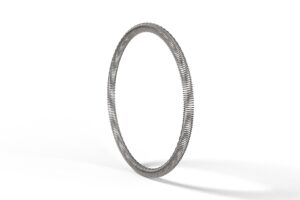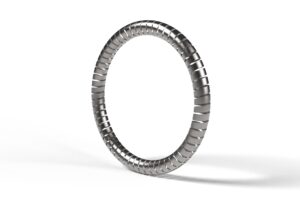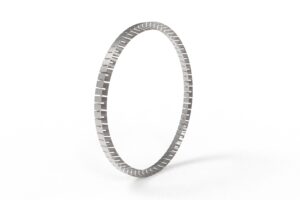
The Flangelock Seal is a single-acting seal composed of a U-shaped jacket and a V-shaped corrosion-resistant metal spring. This seal is notable for its flanged heel, which locks the seal in place within its groove to prevent rotational movement. Additionally, it features a robust and short dynamic lip that enhances its ability to reduce friction, prolongs its service life, and delivers an effective scraping action, especially in highly viscous media.
Furthermore, the Flangelock Seal is designed to excel in a variety of applications, including rotary, reciprocating, and static settings, making it an adaptable solution across diverse industries. Its construction minimizes mechanical torsion and features a low coefficient of friction, ensuring the seal stays securely positioned even during oscillating or helical movements. Enhanced by its ability to withstand rapid temperature fluctuations and boasting high abrasion resistance, the seal demonstrates exceptional aging resistance and effective scraping capabilities. These attributes collectively make the Flangelock Seal a reliable and long-lasting choice for a wide array of sealing applications.
Most spring-energized sealing profiles are designed to be compatible with the three primary spring types. Understanding the differences between these spring types is essential for making informed engineering decisions, particularly in relation to each spring’s load versus deflection characteristics.
Load vs. deflection characterizes how a seal’s spring energizer responds under compression, providing a measure of the force (load) required to achieve a certain deformation (deflection) of the spring element within the seal. This response is pivotal for ensuring adequate sealing pressure against the mating surface throughout the operational life of the seal, compensating for wear, hardware tolerances, and thermal expansions or contractions.
Each spring type can be customized to provide different load profiles depending on the specific load requirements:



Understanding these spring types and their specific applications can help you make informed decisions for optimal sealing performance.
Materials: Available in 302 SS, 316 SS, Alloy C-276, Beryllium Copper, and other alloys. Offered with gold, silver, and nickel plating for electronic and semiconductor applications. Radial cross-sections from 1/32″ to 3/8″, with diameters as small as 0.050″.
Material Benefits:
| Specification | Details |
| Pressure Capacity | Maximum of 3,500 psi. Can vary depending on spring |
| Temperature Range | -270°C to +260°C | -450°F to +500°F |
| Max Speed | 20 ft/s |
| Material | Description | Temperature Range | Wear Resistance | Extrusion Resistance | Abrasion to Shaft |
| Unfilled PTFE | Suitable for light-duty service with the lowest friction and excellent chemical compatibility. It is FDA compliant and white in color. | −450°F to 450°F (−270°C to 230°C) | Low | Low | Low |
| 1130 | 1130 is a polymer and carbon filled PTFE (polytetrafluorethylene) material that is significantly softer than most other carbon filled PTFE’s, but it is a much better sealing material with good wear properties. This material has excellent tensile strength and elongation for PTFE based materials. This material is specifically designed for demanding sealing/wear applications where PTFE is deemed appropriate. | −450°F to 450°F (−270°C to 230°C) | High | Medium | Low |
| Graphite-Filled PTFE | Designed for light-duty service with low friction and very good chemical compatibility. It has good wear resistance in liquids and humid conditions. The color is black. | −450°F to 475°F (−270°C to 230°C) | Low | Low | Low |
| Graphite-Carbon-Filled PTFE | Suitable for general light-duty applications with low friction and very good chemical compatibility. It has good wear resistance in liquids and humid conditions. The color is black. | −450°F to 500°F (−270°C to 230°C) | Medium | Medium | Low |
| 1215 | 1215 is a proprietary, polymer and carbon filled PTFE (polytetrafluorethylene) material. In addition to retaining the exceptional chemical resistance, heat resistance, corrosion resistance, and low friction properties of unfilled PTFE, it also offers significantly improved compressive properties, better wear properties, and low creep under load. It is ideal for oilfield applications as it can effectively handle down-hole chemicals, hydrocarbons, oils, mud, and slurries. Primarily, it is used for dynamic sealing components, such as face seals, packing, riders, and V-packing. It is a significant upgrade from carbon filled PTFE materials normally used in these applications. | −450°F to 500°F (−270°C to 260°C) | Medium/High | High | Medium |
| Moly-Glass Filled PTFE | For extreme conditions, offering excellent extrusion resistance but may be abrasive to soft mating materials. The color is black. | −450°F to 500°F (−270°C to 260°C) | High | High | High |
| Glass-Filled PTFE | Glass fiber improves the wear properties of PTFE, lowers the deformation under load at both high and low temperatures, and increases the impact resistance while leaving the electrical and chemical characteristics of PTFE essentially unchanged. It is suitable for piston rings, valve seats, shaft seals, electrical insulators, bearing pads and gaskets. This material should not be used in contact with strong alkalis and hydrofluoric acid. | −450°F to 500°F (−270°C to 260°C) | High | High | High |
For comprehensive support on housing details or to explore potential solutions tailored to your application, we invite you to book a meeting with us
